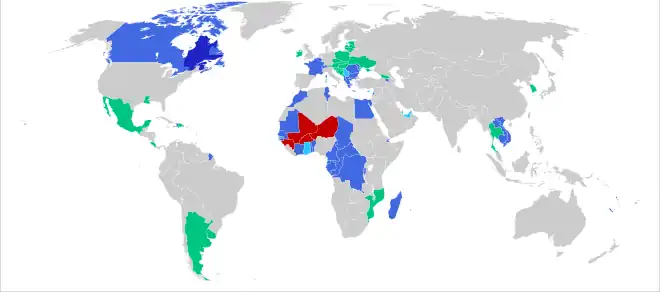

.svg.png.webp)
The Francophonie is the whole body of people and organisations around the world who use the French language regularly for private or public purposes. The term was coined by Onésime Reclus in 1880 and became important as part of the conceptual rethinking of cultures and geography in the late 20th century.[1] The Organisation internationale de la Francophonie is a body uniting countries where French is spoken.
Denominations
Francophonie, francophonie and francophone space are syntagmatic. This expression is relevant to countries which speak French as their national language, may it be as a mother language or a secondary language.
These expressions are sometimes misunderstood or misused by English speakers. They can be synonymous but most of the time they are complementary.
- "francophonie", with a small "f", refers to populations and people who speak French for communication or/and in their daily lives.[2]
- "Francophonie", with a capital "F", can be defined as referring to the governments, governmental and non-governmental organisations or governing officials that share the use of French in their work and exchange.[2]
- "Francophone space", "Francosphere" represents not only a linguistic or geographic reality, but also a cultural entity: for example describing any individual who identifies with one of the francophone cultures, may it be Slavic, Latin, Creole, North American or Oceanian for example.[3][4]
Origins
The term francophonie was invented by Onésime Reclus in 1880: "We also put aside four large countries, Senegal, Gabon, Cochinchina and Cambodia, whose future from a "Francophone" point of view is still very doubtful, except perhaps for Senegal" (in French « Nous mettons aussi de côté quatre grands pays, le Sénégal, le Gabon, la Cochinchine, le Cambodge dont l’avenir au point de vue « francophone » est encore très douteux sauf peut-être pour le Sénégal »); and then used by geographers.[5]
During the Third Republic, the French language progressively gained importance.
The Académie française, a French institution created in 1635 in charge of officially determining and unifying the rules and evolutions of the French language, participated in the promotion and the development of the French language.[6]
See also
- Organisation internationale de la Francophonie
- Agence universitaire de la Francophonie
- Francophone literature
- Institut Français
- Alliance française
- French language in Canada, Lebanon, United States, Minnesota, Vietnam, Laos, and Cambodia
- Swiss, Belgian, and African French
- French-based creole languages
- Influence of French on English
References
- ↑ Alexander B. Murphy, "Placing Louisiana in the Francophone World: Opportunities and Challenges" Archived 10 May 2013 at the Wayback Machine, published in Atlantic Studies, Volume 5, Issue 3, 2008; Special Issue: New Orleans in the Atlantic World, II, accessed 7 April 2013
- 1 2 "Qu'est-ce que la Francophonie ? - Organisation internationale de la Francophonie". francophonie.org. Archived from the original on 5 December 2014. Retrieved 7 July 2016.
- ↑ "Données et statistiques sur la langue française - Organisation internationale de la Francophonie". francophonie.org. Archived from the original on 23 March 2017. Retrieved 7 July 2016.
- ↑ L'année francophone internationale, Québec, ACCT, 1994
- ↑ Pinhas, Luc (2004). "Aux origines du discours francophone". Communication & Langages. 140 (1): 69–82. doi:10.3406/colan.2004.3270.
- ↑ "La Francophonie: The History of the French Language Training School". Language Connections. July 2022. Retrieved 9 February 2023.